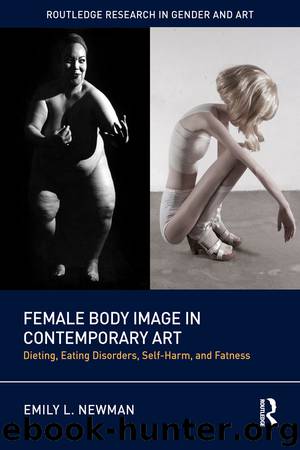Female Body Image in Contemporary Art by Emily L. Newman

Author:Emily L. Newman
Language: eng
Format: epub
Publisher: Taylor & Francis (CAM)
Published: 2018-05-06T16:00:00+00:00
4 Self-Harm
On November 19, 1971, artist Chris Burden was shot. In an unprecedented act titled Shoot, Burden had his friend fire a gun, shooting him in the arm as performance art. Just prior, in April of the same year, Gina Pane ascended a ladder that had razor blades in the rungs. Escalade nonanethesie continued until she could no longer climb because of her injuries. Vito Acconci used a candle to burn off his chest hair on one pectoral in Conversions in the summer of 1971. Once he has removed the hair, he tugs at the flesh trying to pull his chest outward to resemble that of a woman’s breast. In her 1974 project Sorry Mister, Ulrike Rosenbach hit her leg for a sustained period of time, as a deep bruise develops on her thigh. Similarly, Marina Abramovic´ tested her willpower in Rhythm 10 (1973), when she played the risky game of stabbing a knife into the ground between her fingers repeatedly. Each time she cut herself, she would switch to a new knife and moan loudly in pain.1
These shocking performances, experiments in extreme studio art practices, dominated much of the early 1970s performance art. In courting repulsive reactions, these artists sought to destroy what few remaining boundaries existed in the contemporary art world. Kathy O’Dell has written about many of these masochistic performances and events in depth, articulating that these artists “were moved to create metaphors for a type of negotiation—contractual negotiation—that might bring balance to the war-induced instability they were experiencing.”2 In their painful performances, these artists broke new ground artistically but were also finding new ways to interact with the dramatically changing world in the 1970s. These artists all force the viewer to not just question their expectations of art, especially performance art, but to further consider their complicity in witnessing painful actions and, in some ways, providing de facto support.
With enough repeated attempts to explore pain and mutilation, viewers were increasingly fatigued, especially as masochistic artworks continue to be created. Germaine Greer powerfully took these artists to task, saying, “Deliberately disfiguring and damaging strong, healthy young bodies is a work of supererogation if ever there was one.” She continues, referencing Burden’s (in)famous Shoot:
When an artist decides that the work will be purely carnal, it is as if he makes an agreement with himself to be uninteresting. What did Chris Burden imagine would happen when he got his assistant to shoot him in the arm in 1971? Luckily for him, the wound was superficial; the bullet didn’t bounce off a bone and kill a bystander, nor did it lodge in his brain.3
Download
This site does not store any files on its server. We only index and link to content provided by other sites. Please contact the content providers to delete copyright contents if any and email us, we'll remove relevant links or contents immediately.
Still Foolin’ ’Em by Billy Crystal(36259)
Spell It Out by David Crystal(36021)
The Great Music City by Andrea Baker(31251)
Professional Troublemaker by Luvvie Ajayi Jones(29571)
Trainspotting by Irvine Welsh(21488)
Call Me by Your Name by André Aciman(20351)
We're Going to Need More Wine by Gabrielle Union(18951)
The Secret History by Donna Tartt(18810)
Cat's cradle by Kurt Vonnegut(15155)
Ready Player One by Cline Ernest(14496)
Molly's Game by Molly Bloom(14049)
Bombshells: Glamour Girls of a Lifetime by Sullivan Steve(13952)
The Goal (Off-Campus #4) by Elle Kennedy(13476)
Leonardo da Vinci by Walter Isaacson(13149)
4 3 2 1: A Novel by Paul Auster(12263)
The Social Justice Warrior Handbook by Lisa De Pasquale(12126)
The Break by Marian Keyes(9289)
Crazy Rich Asians by Kevin Kwan(9147)
Adultolescence by Gabbie Hanna(8836)
